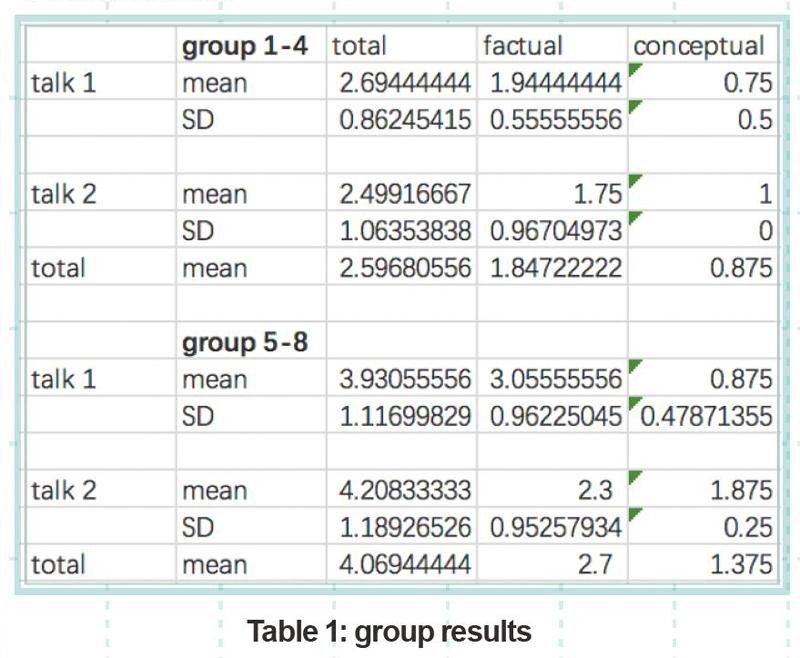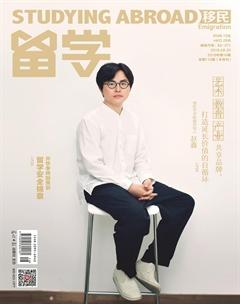Comparing longhand and laptop note—taking methods on task performance
陈叶伊格

Abstract
In colleges, professors usually teach classes by giving lectures. Therefore, students take notes to record the contents. Students usually employ one of these two methods for note-taking: longhand and typing on a laptop. There are many studies that have been done to discover which of the two methods is more beneficial for students to acquire certain knowledges. One of them is an experiment from Mueller and Oppenheimer in 2014. Since there may be selection effect by replicating the experiment and assigning students into two groups, this study employs repeated measures as a within-groups design to ask each participant to take notes twice. By comparing the scores the same group of students get on a list of questions after hearing two lectures, this study shows a similar result as Mueller and Oppenheimers study. There is also a difference between students performance on factual and conceptual questions. However, the results may simply be due to group difference because of the within-group design rather than the actual influence of the different modes of note-taking.
Keywords: Note-taking, Lecture learning, Longhand, Laptop, Task performance.
Introduction
In todays classrooms, over two thirds of instruction involves some type of lecturing. Note-taking is then employed by most students as a way of learning that both enhances their reflection and helps them develop analytical skills. In addition, students can refer to the information for later study and comprehension of the materials (Boyle, 2010). However, researches found that students dont take notes efficiently for they only get approximately 25% of the lecture material (Boyle, 2010).
Note-taking has been demonstrated to have several benefits on students. Students who use different methods of note-taking also generate different types of notes. For example, researchers found that students who produce more non-linear notes, represent information in a more connected and meaningful way than traditional note-takers. They also show a deeper understanding of the materials and more integrated knowledge management (Makany et. al 2009).
In “The Pen Is Mightier Than the Keyboard: Advantages of Longhand Over Laptop Note Taking” (Mueller, 2014), Mueller and Oppenheimer did a study to compare the different effects of longhand and laptop note-taking methods on task performance by giving students TED talks and then complete certain tests. However, this experiment was done on different groups of students, so there may be the problem of selection effects.
Given the background and benefits of note-taking, the purpose of this study is to modify the study of Muller and Oppenheimer in 2014 and see whether within-group design could fix some potential problems that the previous study hasnt thought about and come up with better and more reliable results. By comparing the data, this study would show which of the methods is more beneficial as a means of note-taking. Then, students can refer to this study and take notes accordingly to improve their learning.
Experiment Design
I.Participants
Participants were 8 students (4 male, 4 female) from the Introduction of Psychology course in Special A Shanghai subject pool. One of the experimenters also participated in the experiment as a student, while the other two served as the instructors in each room.
II.Materials
We selected two of the five TED talks (https://www.ted.com/talks) for length (slightly over 15 min) and to cover topics that would be interesting but not common knowledge from the supplementary materials that the original study provided.
III.Procedures
8 Students were divided into two groups, and each group had two girls and two boys. One of the group remained in the original classroom while the other group was taken to another classroom. Lectures were projected onto a screen at the front of the room. Participants were given a sheet of paper that listed all the instructions for them to follow. There were also one instructor in each room to read the instructions out loud and answer any questions. The students were instructed to use their normal classroom note-taking strategy, because experimenters were interested in how information was actually recorded in class lectures.
After hearing the lectures and taking notes, students were instructed to take an online IAT test. Then, all the students responded to both factual and conceptual questions on the sheet of paper that the instructor distributed.
Then the same instructions were given for the students to take notes using a different method.
All three experimenters scored the questions based on the scale of the original study, and the final scores were recorded according to their discussions.
Discussion
In this study, repeated method was used in a within-group study to account for the problem that it may be the contents of the videos that are actually affecting students performance. However, the results showed more of a group difference and the results are quite similar to Mueller and Oppenheimers. Therefore, thats maybe why they didnt bother to do the study on the same group of students.
Group 1-4 and 5-8 are different two groups that each listened to both of the talks. The group mean suggests that group 5-8 did better overall than group 1-4, which means there could be difference between the students.
For the factual questions, we are not confident to say that mode of note-taking makes a difference (d=0.49). For conceptual, it seems that writing by hand outperforms laptop (d=1.3). But for group 1-4, it went the other way. Therefore, the difference may be more because of the group difference.
Overall, we seem to get similar results as Mueller and Oppenheimers, even though we used a different mode of testing. As a result, Mueller didnt bother to use different lectures, the different scores may just account for the contents of the lectures.
To resolve some potential problems that occurred, we can use a larger number of subject pool next time. Second, instead of randomly choose students to be in the two groups, we can use matched groups method to assign students to be in different groups. Third, we can show a controlled video where everyone uses the same mode before the study, to see if the two groups are substantially different.
Note:
All materials used in this study are from the original study of Mueller and Oppenheimer in 2014 “The Pen Is Mightier Than the Keyboard: Advantages of Longhand Over Laptop Note Taking”.
Reference:
Boyle, J. R. (2010). Note-taking skills of middle school students with and without learning disabilities: 4/13. Journal of learning disabilities. 43(6), 330-340.
Boyle, J. R. (2010). Strategic note-taking for middle-school students with learning disabilities in science classes. Learning Disability Quarterly. 33, 93109.
Makany, T., Kemp, J., & Dror, I. E. (2009). Optimising the use of note-taking as an external cognitive aid for increasing learning. British Journal of Educational Technology, 40, 619635.
Mueller, P. A., & Oppenheimer, D. M. (2014). The Pen Is Mightier Than the Keyboard: Advantages of Longhand Over Laptop Note Taking: 5/22. Psychological Science.
陳叶伊格
18岁 费城
Friends Central School,开学十二年级,目标专业:心理学
在这个暑假,我参加了心理学的暑校项目以及与其相关的行为的生物性研究。在课上,我不仅仅学到了很多基本的生物知识,比如大脑的构造,还学到了更多更为复杂,关于人们一些的行为的机理原因。我发现心理学是一门很有趣,知识面也很丰富的学科。因此,在跟着教授的研究课程中,我们从理论知识开始,一步步的讲如何设计实验,需要注意的方面,关于数据的处理,SPSS的运用,等等。最后我们在本班同学不知情的情况下进行了一次实验,我以实验者的身份也参与了其中。虽然这次实验比较简单,但是在这次实验中,我体会到了真正的实验步骤是什么样子的,以及其严谨科学性。之后,在和教练的讨论中,我们把获得的数据进行计算分析,看到了我们的实验结果,最后我也是写出了这份实验报告。经过这将近一个月的时间,我对于心理学有了基本的了解,也产生了更强的兴趣,如果以后大学专业选择了心理学,我相信我会更加努力地学好更多的知识。

